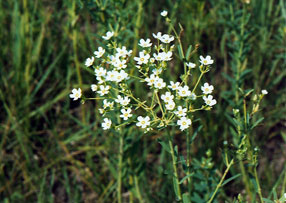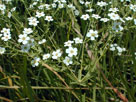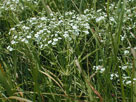FLOWERING SPURGE
|
 |
| File Size: 92 KB |
|
|
|
Euphorbia corollata L.
|
| Riley County, Kansas |
| Perennial |
| Height: 8-40 inches |
| Family: Euphorbiaceae - Spurge Family |
| Flowering Period: June, July, August, September,October |
|
| Stems: | | Erect, solitary or few, usually simple below, few- to much-branched at top, pale green to yellowish-green, glabrous. | | Leaves: | | Alternate on stem, often opposite in inflorescence; upper stem leaves in whorl below inflorescence; simple, sessile, often ascending, oblong or narrowly elliptic, .8 to 2.4 inches long, usually less than 1/2 inch wide, green to light green; margins entire; surfaces glabrous or sparsely to moderately pubescent; base rounded or narrowed; tip rounded or rarely sharply pointed; upper leaves reduced. | | Inflorescences: | | Cyme, corymb-like or panicle-like, many-flowered, up to 14 inches across, terminal and in axils of upper leaves; flowering stalks 3-10, branching; branches usually branched additional times. | | Flowers: | | Receptacles, cup-like, solitary at branch tips, short-stalked, with 5 petal-like appendages attached around rim of cup; appendages conspicuous, 1/20 to 1/6 inch long, white; yellowish glands at base of each appendage; staminate flowers 10-21; pistillate flower 1, with 3 styles; petals and sepals absent. | | Fruits: | | Capsule, on short stalk, 3-lobed, 1/10 to 1/6 inch long, glabrous; seeds 3, egg-shaped, about 1/10 inch long, gray or light brown, mottled. | | Habitat: | | Rocky prairies, pastures, open woods, roadsides, stream and river banks, old fields, fallow fields, waste places, thickets; dry or sandy or clay soils. | | Distribution: | | East 2/5 of Kansas | | Origin: | | Native | | Reproduction: | | By seed and by rhizome | | Toxicity: | | Poisonous but rarely fatal. Cattle will avoid grazing it, but sometimes ingest it in hay. Symptoms include vomiting, diarrhea, and excessive salivation. The milky sap can cause skin irritation in humans. | | Uses: | | The root was used to treat toothaches and was boiled and the liquid taken for rheumatism. The plant was boiled and taken to treat gonorrhea and boiled with herbs and the liquid taken to treat cancer. The sap was applied to sores. | | Comments: | | Flowering spurge is pollinated by flies and short-tongued bees. The capsule snaps open when the seeds are ripe, ejecting the seeds some distance. Named in honor of Euphorbus, a Greek physician in the first century who used the sap of plants in this family medicinally. Latin corollatus, "possessed of a corolla". The common name spurge is derived from Latin expurgare, "to purge or cleanse". |
|
| Flowering spurge |  | | 116 KB | | Riley County, Kansas |
| | Flowering spurge |  | | 80 KB | | Riley County, Kansas |
| | Flowering spurge |  | | 53 KB | | Wildcat Glades Conservation & Audubon Center, Newton County, Missouri |
| | Flowering spurge |  | | 53 KB | | Morris County, Kansas |
| | Flowering spurge leaves |  | | 49 KB | | Wildcat Glades Conservation & Audubon Center, Newton County, Missouri |
| | Flowering spurge |  | | 129 KB | | Morris County, Kansas |
| | Flowering spurge |  | | 37 KB | | Douglas County, Kansas |
| | Flowering spurge fruit |  | | 49 KB | | Leavenworth County, Kansas |
| | Flowering spurge leaves |  | | 103 KB | | Morris County, Kansas |
| |
|
|
|
|
|
|